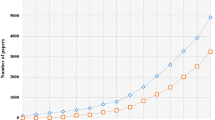Abstract
In an earlier study the authors have shown that bibliographic coupling techniques can be used to identify ‘hot’ research topics. The methodology is based on appropriate thresholds for both number of related documentsand the strength of bibliographic links. Those papers are calledcore documents that have more than 9 links of at least the strength 0.25 according toSalton's measure, provided they are articles, notes or reviews. This choice resulted in a selection of nearly one per cent of all papers of the above types recorded in the 1992 annual cumulation of the SCI.Core documents proved important nodes in the network of documented science communication.
In the present study, the set ofcore documents is analysed by journals, subfields and corporate addresses. The latter analysis is conducted on both national and regional-institutional level. First all countries which have published at least 20 core documents in 1992 are investigated in terms of their research profiles, their international collaboration patterns and their citation impact. Finally, those eight members of the European Union which have published at least 20 core documents in 1992 are analysed in respect of regional and institutional distribution of core documents.
Similar content being viewed by others
References
H. Small, Co-citation in the scientific literature: A new measure of the relationship between two documents,Journal of the American Society for Information Science, 24 (1973), 265–269.
I. V. Marshakova, System of connections between documents based on references (as the Science Citation Index),Nauchno-Tekhnicheskaya Informatsiya, Seriya 2 No. 6 (1973), 3–8 (in Russian).
M. M. Kessler, Bibliographic, coupling between scientific papers,American Documentation, 14 (1963), 10–25.
J. King, A review of bibliometric and other science indicators and their role in research evaluation,Journal of Information Science, 13 (1987), 261–276.
D. Hicks, Limitations of co-citation analysis as a tool for science policy,Social Studies of Science, 17 (1987), 295–316.
G. Vladutz, J. Cook, “Bibliographic coupling and subject relatedness”, In: 1984:Challenges to an Information Society, Proceedings of the 47th ASIS Annual Meeting (compiled by B. Flood, J. Witiak, T. H. Hogan), White Plains: Knowledge Industry Publications, 1984, pp. 204–207.
J. T. Sharabchiev, Comparative analysis of two methods of cluster analysis of bibliographic references,Nauchno-Tekhnicheskaya Informatsiya, Seriya 2, No. 4 (1988), 25–28 (in Russian).
W. Glänzel, H. J. Czerwon, A New Methodological Approach to Bibliographic Coupling and Its Application to Research-Front and Other Core Documents,Proceedings of 5th International Conference on Scientometrics and Informetrics, held in River Forest, Illinois, June 7–10, Learned Information Inc., Medford, 1995, 167–176.
S. K. Sen, S. K. Gan, A mathematical extension of the idea of bibliographic coupling and its applications,Annals of Library Science and Documentation, 30 (1983), 78–82.
A. Schubert, T. Braun relative indicators and relational charts for comparative assessment of publication output and citation impact,Scientometrics, 9 (1986) 281–291.
A. Schubert, W. Glänzel, T. Braun, Against Absolute Methods Relative Scientometric Indicators and Relational Charts as Evaluation Tools. In: A. van Raan (Ed.),Handbook of Quantitative Studies of Science and Technology. Elsevier Science Publisher B.V., 1988, 137–176
W. Glänzel, A. Schubert Characteristic scores and scales in assessing citation impact,Journal of Information Science, 14 (1988) 123–127.
W. Glänzel, A. Schubert, Some facts and figures on highly cited papers in the sciences, 1981–1985,Scientometrics, 25 (1992), 373–380.
W. Glänzel, H.-J. Czerwon, What are highly cited publications ? A method applied to German scientific papers, 1980–1989,Research Evaluation, 2 (1992), 135–141.
Author information
Authors and Affiliations
Rights and permissions
About this article
Cite this article
Glänzel, W., Czerwon, H.J. A new methodological approach to bibliographic coupling and its application to the national, regional and institutional level. Scientometrics 37, 195–221 (1996). https://doi.org/10.1007/BF02093621
Received:
Issue Date:
DOI: https://doi.org/10.1007/BF02093621




